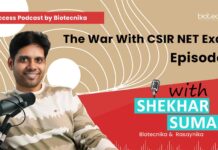Drug use in the Ancient World
Voice of Biotecnika: Episode – 47
We wish there was a pill for everything. From the days we are feeling low to curing the constant pangs of hunger during work. From stress-related hypertension to disturbed sleep and insomnia at night. That day is not far when there would be a library of such treatments available to relieve us from their untimely attack. But where did all of this start from? What were the first disease and its cure? Isn’t excessive use of medication bad for health? Then how was its use controlled in the ancient world?
Welcome back to another illuminating episode on Voice of Biotecnika. I, Rashmi, will divulge various facts related to the use of drugs and medications in the ancient world – Drug Use in the Ancient World. So, sit tight and buckle up for a short journey, taking us back in time.
Archeological evidence suggests that the ancient world depended on many natural concoctions that would treat mankind or even could be a reason for their enhanced intelligence that is well portrayed behind their genius theories and philosophies. Not only did these compounds have immense use in healing the
society, but they also were compounds that were used for its hallucinating and psychoactive properties. Such compounds can be traced to be found throughout the world, under multiple civilizations and in the most incredible and inconceivable locations. For example, imagine finding them in mummies or in the ruins of burned down cities of the ancient world!To analyze this further, the area or location of the presence of such compounds were traced by archeologists. For example, whether such compounds were occasionally found in the old house ruins or whether there were special manufacture and store areas created for these. Incidentally, a lot many such concoctions and elements were found near-religious areas. This gives us the impression that psychoactive and hallucinating agents might have been used during the performance of many rituals. For example, older civilizations believed in accessing the spirit world for the purpose of healing oneself. Here, the compounds were not used for its recreational benefits, as we perceive them to be in the modern days. Rather they were used to get spiritual oneness and to derive energy from the non-physical realm.
A lot of ancient civilizations were in use of these. What was the effect that it had on society? Why is the use of such chemicals regarded as abuse today? In our present-day society the use of many of these chemicals are regarded as “outside the norm” or even illegal in some nations!
The trouble in solving this mystery lies in the fact that the exact usage of all such chemicals was considered a secret in many societies. There is hardly any written evidence associated with each. Modern-day critics and writers usually assume the usage by tracing their presence down in history. For example, in an ancient burned down the city, archeologists began tracing the kind of materials predominant in the house kitchen. Astonishingly, the kitchen did not have a huge supply of bread or meat or any of the common food of those days, but there were huge supplies of opium. On looking further, there were huge feasting rooms associated with the kitchen, that indicated that when the material was produced in the kitchen, they were consumed in huge amount by a large number of people. This could have been a ritual or a ceremony. The purpose of such gatherings, however, can only be anticipated. Since the then civilization regarded this knowledge as a sacred mystery, they did not carve it on the then present stone tablets, due to which there is hardly any concrete evidence pertaining to their usage. In many tribal traditions, the ability to communicate with spirits and other entities was a prized skill and much respect was given to the shaman or priest who could facilitate this kind of interaction.
Similarly, alcohol, wine, herbs, concoctions were found almost in every civilization. In Egypt, when famous tombs were dug open, there was evidence of blue water lilies covering the mummy of famous Kings. These lilies behave as a very strong psychoactive drug when soaked in wine for a few weeks.
We can only presume its usage. There are even medicinal values associated with such herbs that would initiate natural healing. One such example is Cannabis whose use is still undergoing debate in today’s world. On one hand, a 27000-year-old grave in Western China shows that it has psychoactive properties, while on the other hand they were used as meditation aids and painkillers by Sikhs for many generations.
Nutmeg is one such other compound that shares its value in the food industry, and also in the medicinal world. Nutmeg is used in the treatment of asthma and heart troubles, but when consumed in large amounts it has dangerous side effects. It was also used as sedatives.
The Romans and the Greeks used opium, as well as numerous botanical toxins to induce states of mental euphoria, create hallucinations, and alter their own consciousness. If such compounds had such a wide variety of usage listed throughout history and civilization, then how did its use become so restricted today?
Drug addiction is characterized by an inability to abstain from the drug; impaired behavioral control; cravings for the drug or other pleasure-seeking activities which stimulate the same reward pathways; diminished recognition of behavioral problems; and a dysfunctional emotional response. In this case compounds like sugar, herbs, spices, coffee would all be termed as drugs as their prolonged use may harm mankind. But since they are readily available and marketed with awareness, their use is not abused.
Health professionals and senior ranking police officials agree that much harm could be avoided if we let go of the stigma and secrecy surrounding drug use and instead focussed on helping those who experience the problems associated with addiction in a balanced and non-judgemental way.
Accepting the significance of drug use throughout history and in virtually all traditional cultures around the world would go a long way to overcoming the taboo which is preventing the rational exploration of their continued use. The human appreciation for the healing, sacred, entertaining, bonding, pain-relieving and mood-altering experiences that drugs provide is not going to go away – the tradition of their use is simply too strong and too significant.
Drug Use in Ancient World – If we look into the history of medicine, we can find how societies have changed in their approach to diseases and illness from ancient times to the present. The Renaissance period had improved understanding of anatomy, and the microscope was invented. Although there is no record to establish when plants were first used for medicinal purposes (herbalism), the use of plants as healing agents, as well as clays and soils is ancient. Over time, by following the behavior of fauna, a deep medicinal knowledge base developed and was passed across generations. Even earlier, Neanderthals might also have engaged in medical practices. Among the tribal society, specialized casts – shamans and apothecaries used to function as healers. Shamans were known to enter the spiritual world by entering into a trance while the healing process. The ancient Mesopotamians had no distinction between “rational science” and magic. To treat a patient – recitations and chants, as well as herbs and other such magical medications, were administered. The earliest medical prescriptions appear in Sumerian during the Third Dynasty of Ur. In ancient Egypt, the practice of medicine is so specialized among them that each physician is a healer of one disease and no more. Medical information appears in the Edwin Smith Papyrus, an ancient Egyptian medical text, and may date to a time as early as 3000 BC. The Atharvaveda, a sacred text of Hinduism dating from the Early Iron Age, deals with medicine and is said to be one of the first Indian texts to do so. The Atharvaveda also contain prescriptions of herbs for various ailments. The use of herbs to treat ailments would later form a large part of Ayurveda. Charaka Samhita, Sushruta Samhita includes the knowledge of preserving health and even techniques to modern-day surgery. Hippocrates is considered to be the father of modern medicine. He and his followers are presumed to be the first to describe many diseases and medical conditions. The Romans invented numerous surgical instruments, including the first instruments unique to women. As we advanced into the latest centuries, advanced research centers opened and are often connected with major hospitals. Medicine was heavily professionalized by the 20th century.
There must be some reason behind the fact that why in ancient times, different clans of people started to intentionally select, prepare, and consume various substances that contain certain chemicals. Should the basis of their understanding just be left out to dilute amongst the many theories that modern-day man believes in? Or should we continue to believe in the ancient potions and magic that is the essence of many civilizations each of us seems to have descended from?
If you find this topic – “Drug Use in Ancient World” interesting do share your comments below and stay tuned to the upcoming sessions filled with such absorbing and engrossing subject matters.
Wishing you all a great day ahead!
 most experienced & senior team members of Biotecnika. Coming from a research background in cancer, she specializes in Cancer Genetics, Immunology & Developmental Biology. She has a keen interest in understanding the latest developments in Biotech & Pharma Industry and is very passionate about educating the same to her students. This Podcast on – Drug Use in the Ancient World has been compiled by her after thorough analysis.
most experienced & senior team members of Biotecnika. Coming from a research background in cancer, she specializes in Cancer Genetics, Immunology & Developmental Biology. She has a keen interest in understanding the latest developments in Biotech & Pharma Industry and is very passionate about educating the same to her students. This Podcast on – Drug Use in the Ancient World has been compiled by her after thorough analysis.








































This topic is really of my interest as I am working in plant metabolomics and loved the writing. I would really like to say that whatever Ayurveda or ancient medicinal practices claim that need to be verified scientifically as the dosage of every medicine whether herb-based or synthetic matters most. Just like synthetic medicine herbal medicinal consumptions can also give adverse side effects which often turn out to be irreversible. So any drug or an herbal decoction or anything similar should be taken from a knowledgable practitioner (which is very less). That’s why herbal consumption is still treated as an alternative treatment.
Sir I want to work
The podcast was interesting. My interest is tending towards pharmaceutical biotechnology, therapeutic benefits from medicinal plants. I believe if materials are taken from mythological literatures, they could provide us with innumerable base for yet not discovered remedies for diseases. I want to carry my research work in pharmacophre modelling, medicinal plants. I am finding and joining links between the same.